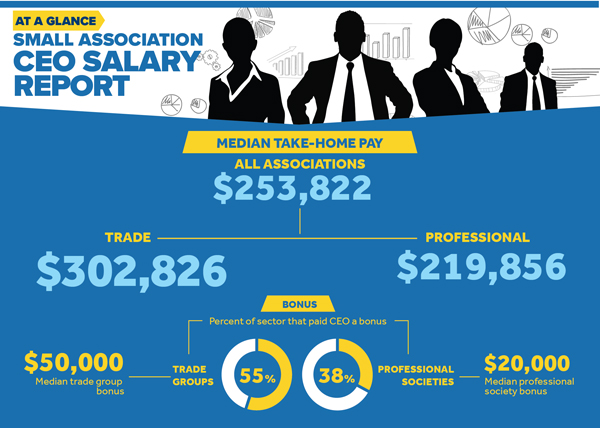Small-group pay rises, is comparable to some midsize groups
Small-group pay rises, is comparable to some midsize groups
- November 8, 2019 |
-
 WILLIAM EHART
WILLIAM EHART

Median change in CEO compensation is 3.6%, with big contribution from bonuses

Smaller-group CEO salaries continued their modest but steady upward march with another year of a median increase of 3.5% or higher.
CEO Update analyzed the most recent tax filings for associations with revenue between $2.5 million and $5 million. The median change for executive base-and-bonus pay was 3.6%, on par with 3.5% the year before but down a bit from 3.9% in our 2017 survey. Small-group leaders again trailed their counterparts at midsize and large associations, where the median change in our 2019 report (compared to the 2018 survey), was above 4%.
However, compensation at these smaller groups is not as far below that at midsize groups as one might expect, given that association revenue is the biggest determinant of compensation.
Mark Graham, CEO Update's in-house compensation expert, said the report suggests that there is a de facto minimum wage for association executive leadership.
Two data points make the case: the median and the 10th percentile.
Median pay—the point at which half of CEOs earn more and half earn less—for CEOs who lead organizations with revenue between $5 million to $7 million is only 19% more than that in the smaller associations. That's only a $47,000 pay bump to run organizations with a median budget 63% larger and 50% more staff. And pay at the 10th percentile—the point at which 90% of CEOs earn more—is just $28,000 apart.
The median revenue of associations in our small group survey this year was nearly $3.6 million, in line with previous years. The median take-home pay (base, bonus and other) of all trade association CEOs in the report was $302,826, compared with $219,082 for professional society leaders.
But in a departure from previous small-group reports, the median change in trade association CEO compensation was much higher (3.8%) than that for professional society chief executives (3.0%). At larger groups, it's common for trade association pay to rise faster than professional society compensation year after year.
Lyn McCloskey, a principal and compensation expert at consulting firm PRM, said the firm's own data shows that base pay among smaller nonprofits rising in the 3% range—about in line with salary increases for all employees at such groups. What is different is that at-risk pay as a percentage of compensation is rising for the chief executives.
Gender gap
Gender representation among CEOs at smaller groups is another topic worth examining. Thirty-seven percent of chief executives in the small-group survey are women, compared with 33% in midsize associations ($5 million to $12 million in revenue) and 27% in the largest groups (revenue above $12 million).
McCloskey said promotions from within may partially explain the gap: Such internal advances to the top spot may be more common at smaller groups than larger ones. Larger groups are more likely to hire from the outside, whether from another association or from industry, where men dominate the talent pool, she said.
